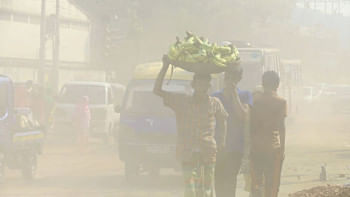The promise beyond tragedy

It was super easy wearing a "geta", the iconic wooden Japanese footwear that Japanese women effortlessly wear with their kimonos. So I bought one last week for only USD 10 in Mitsukoshi, the Japanese version of Harrods in Tokyo, and was followed out by a saleswoman, who waited with her head bent in respect till my elevator left the floor. In the store, I noticed our own Nakshikantha products, designed and imported from Jessore by a young designer couple, and our very own jute "shatranjee" under the brand Aji. Somehow, deep down inside, it felt great to be standing there. Even beyond the store, I discovered "Mother House", another Japanese brand of bags that is sourced from Bangladesh and quietly flaunts the lovely lungi lining inside. The leather looked impeccable and the Bangladeshi workmanship was exquisite. The bags were selling at USD 400-1000 range per piece. The importer was a woman.
How visible are women in Japan? Japan is a country with a gender equality ranking sliding to 111 (out of 144 countries in World Economic Forum ratings) in 2016 while Bangladesh leads at 72nd position, beating all the other South Asian countries. Naturally, I am curious about Japanese women. Two weeks ago, in an international forum where I was hosted by UN Women, I had the opportunity to meet an amazing woman, Hiroshi Koike, the first-ever female governor of Tokyo, elected in June 2016. In July 2017, the same woman had floated a "political school" with 50 candidates (many of them first-timers in politics), who had contested in Tokyo assembly election and won 49 seats. Today, Koike San ("san", meaning respectfully), still a member of the LDP, is in charge of one-third of the Japanese budget that runs into trillion and is most enthusiastically planning the 2020 Olympics in Tokyo. It is widely rumoured that this woman is set to be a leading figure in Japanese politics in a short while. According to Koike San, it's important to be the "first penguin", to take the first leap of faith. That message is clear. Japanese women are just getting ready for a new era of freedom and fulfilment.
I was further enlightened to learn a critical point from a friend, Kathy Matsui (who has been credited by the Japanese Prime Minister Shinzo Abe for having coined the term "womenomics"), that by 2030, Asia would drive the consumption growth with consumption rising in China and India and shifting from basic to discretionary. With a fast-aging Asia, she said, it was time to use more women in Japan and invest in gender diversity, because gender diversity was not about CSR, but rather about profitability. But along with this came another realisation: the disparity in Japan wasn't just being caused by simple male mindsets, it was actually stemming from most men having vested interests in money and authority. So, the game there is more complex than ever.
Thanks to our brilliant ambassador in Japan, Rabab Fatima, who not only hosted me over fusion meals that Anguri, her star chef from Bangladesh, had prepared for the 48 hours that I was in Tokyo, but also facilitated my meetings with Japanese businessmen and generously contributed to my food for thought. Through her, I ended up meeting a number of happy Japanese businessmen including one who was already sourcing readymade garments from Bangladesh and had set up his own factory in Narayanganj, attempting now to export dried tomatoes to Japan. Interestingly enough, though "Uniqlo" import from Bangladesh was done, the company has continued supporting a noble cause of funding Asian University for Women, which is attended by over 50 female workers from readymade garment factories in Bangladesh.
A critical examination of our trade balance with Japan brings in a few interesting statistics. While the Japanese import of apparel had shrunk to JPY 2,910 billion in 2016, Bangladesh remained amongst the top four exporting countries in both quantity and amount. At a glance, Japanese export had increased 7.5 times between 2005 and 2015. In 2016, our export to Japan had grown at 12.57 percent due to relaxation of rules of origin from April 2015, enabling the way for knit garments to be exported to Japan with ease. In 2016-2017, Japan ended up being Bangladesh's 9th largest export market.
While on the one hand the Holey episode in July 2016 took its own toll, we also need to understand that a drop in export to Japan is reflective of the overall downward trend for exports from Bangladesh to most major destinations. On the other hand, export from Japan is growing and the two-way trade even with a drop is over USD 2.5 billion. To top it all, the 38th ODA loan package signed on June 28 was JPY 178 billion, which was the highest ever. This includes Matarbari, Metro, Kanchpur bridge, airport extension, etc. We also need to understand that in spite of security, infrastructure (land, energy), logistics, red tape, tax concerns that bug the Japanese investors, the trade between the two countries continues to flow in a positive direction. On a more positive note, our government has already awarded one Special Economic Zone to the Japanese in Araihazar in Narayanganj. The second SEZ handover is yet to happen. And apart from Bangladeshi traditional export niche with readymade garments, leather and footwear are also in demand, with additional possibilities of collaboration in all other sectors including food, real estate, deep-sea fishing and IT. The next big dream can very well be automobiles!
Therefore, a last note of caution to all of us who read, write and rip news apart on a daily basis: while we cover tragedies like Holey Artisan, we have to grow hopeful about what awaits us in the bigger picture. While, after Holey, the Japanese have continued to support us, let us seize this opportunity and move beyond tears with a renewed faith and pledge to be their best partner ever.
Rubana Huq is Managing Director, Mohammadi Group.





Comments